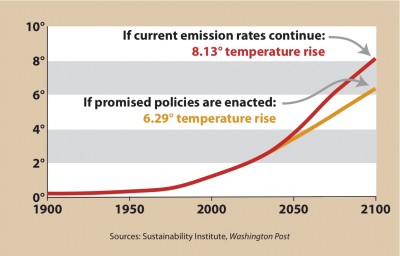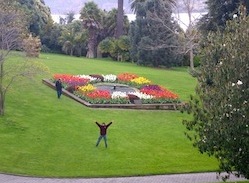Government climate policies are a road to ruin, according to a UN study. If we want to avoid dangerous climate change we must try to bring CO2 concentrations down to 350 parts per million. [13 October 2009 | Peter Boyer]

A UN survey of recent scientific research found that current national policies would lead to global warming of nearly 6.3°C by the end of the century.
If Kevin Rudd and Malcolm Turnbull are feeling the heat over the climate summit in Copenhagen in December, here’s why. A big UN survey of recent scientific research has revealed the terrifying inadequacy of current national promises to cut carbon emissions.
Science tells us that a 2°C global temperature rise above pre-industrial levels is a danger point, above which we really don’t want to go. If we get to 6°C we’re fast approaching Armageddon, with civilisation long vanished and only polar regions able to sustain life.
But Armageddon, it would seem, is where our governments are taking us.
The UN Environment Programme’s just-released 2009 Science Compendium has revealed that the present global emissions trajectory will bring us warming of over 8°C by the end of the century. If currently-promised national policies come to fruition, we’ll keep the rise down to around 6.3°C.
This is the result of the yawning gap between scientific evidence and political “realism”. Our political masters — and we must include opposition politicians in this as well as governments — seem incapable of understanding that urgent and decisive action is the only option.
They’re not alone, of course. Some business leaders and senior bureaucrats, apparently unperturbed by the evidence, behave as if we can continue business as usual while postponing reform.
The Rudd government’s emissions scheme, with its enormous subsidies to heavy-polluting big business, aims for a target that if universally adopted would put the world on a path to above 550 parts per million of greenhouse gases in the atmosphere. Despite this, opposition members are arguing that business is being too harshly treated. What planet are they on?
Far from allowing the level of carbon in the atmosphere to rise well above its present 390 parts per million, science is telling us that we’ve somehow got to find a way to reduce it, and quickly.
Early last year, Dr James Hansen, chief scientist at NASA’s Goddard Institute, warned that 350 ppm was the absolute upper limit if we want our planet to stay the way it’s been throughout our civilised existence. The paper used evidence from past ice ages to show that anything above that would raise warming above the danger level of 2°C.
On the basis of this landmark paper, long-time US environmental activist Bill McKibben set up a group called 350.org, calling for world action to reduce carbon dioxide levels to below what Hansen’s research team had found to be a safe upper limit.
This will be a tough assignment. Recent emissions have already brought melting of polar and mountain ice, rising sea levels and devastating droughts and storms. The task will demand a much speedier shift from fossil fuels to renewable energy than envisaged by government and business.
But it must be done. Next Saturday week, 24 October, has been designated by 350.org as the “International Day of Climate Action”. Concerned people around the world have taken up its call to demonstrate to political leaders and the public at large the critical urgency of this mission. They especially want to make an impression on those attending the Copenhagen summit.
Thousands of events around the world on the day will include city rallies, mountaintop banners, island protests against seawater inundation, religious ceremonies, sporting events and numberless community-organised demonstrations. Each event will highlight the number 350, a photograph of which will be posted at www.350.org as part of a “global visual petition”.
I don’t easily take to public demonstrations, but this is a global event I’ll be very glad to be part of.
X marks the spot: Organiser Lorraine Perrins stands on the site of the “350” display in Hobart’s Royal Tasmanian Botanical Gardens, to highlight the 350 ppm carbon level that the Copenhagen meeting needs to aim for.
Tasmania’s call to climate action
Botanical gardens in southern and northern Tasmania: The Royal Tasmanian Botanical Gardens in Hobart and the Tasmanian Arboretum, Devonport will host “350” collages for the International Day of Climate Change Action on 24 October. Visitors to both venues are invited to add supplied plant material to help to create a “350” collage. The Hobart collage will be on the lawn near the Floral Clock, to emphasise that time is running out for effective action on climate change.
Losing Tasmania — A procession of precious things will be an evening event in Hobart, starting at 7.30 pm on 24 October. Organisers Neil Cameron and Environment Tasmania are seeking 350 people to register for a procession from Hunter Street to St David’s Park, Hobart, in which each participant carries a symbol of what is precious to them in their lives. To register, email hobart350project@gmail.com
The “Windmill” Royal Park picnic will be held from 1-4 pm, Royal Park, Launceston. The aim of this family event is to make paper windmills and plant them in the ground to form a massive “350”. More information from 350.org.
350 Day Picnic at The Gorge. Guests at this event will form a large “350” in spectacular Cataract Gorge. Contact Amy 0424626427 or email.
Human 350 sign: At 12 noon in the Styx Valley (2 hours’ drive from Hobart), people will gather under forest giants to make a visual reminder of the role of our forests in stabilising greenhouse gas concentrations in our atmosphere.
St Helens: Get on your Bike. A bike ride ending at St Helens Wharf at 2pm for a 350 photo. Click here for more information.

